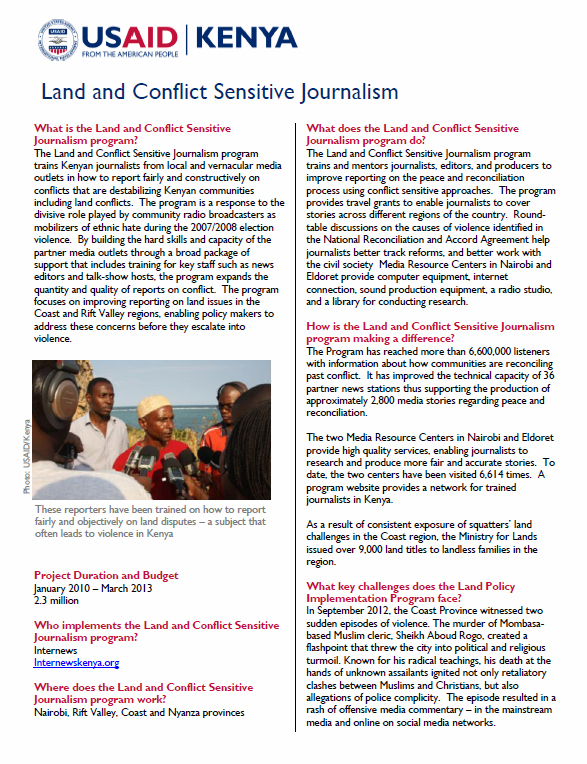What is the Land and Conflict Sensitive Journalism program?
The Land and Conflict Sensitive Journalism program trains Kenyan journalists from local and vernacular media outlets in how to report fairly and constructively on conflicts that are destabilizing Kenyan communities including land conflicts. The program is a response to the divisive role played by community radio broadcasters as mobilizers of ethnic hate during the 2007/2008 election violence. By building the hard skills and capacity of the partner media outlets through a broad package of support that includes training for key staff such as news editors and talk-show hosts, the program expands the quantity and quality of reports on conflict. The program focuses on improving reporting on land issues in the Coast and Rift Valley regions, enabling policy makers to address these concerns before they escalate into violence.
Project Duration and Budget
January 2010 – March 2013
2.3 million
Who implements the Land and Conflict Sensitive Journalism program?
Internews
Internewskenya.org
Where does the Land and Conflict Sensitive Journalism program work?
Nairobi, Rift Valley, Coast and Nyanza provinces
What does the Land and Conflict Sensitive Journalism program do?
The Land and Conflict Sensitive Journalism program trains and mentors journalists, editors, and producers to improve reporting on the peace and reconciliation process using conflict sensitive approaches. The program provides travel grants to enable journalists to cover stories across different regions of the country. Round-table discussions on the causes of violence identified in the National Reconciliation and Accord Agreement help journalists better track reforms, and better work with the civil society Media Resource Centers in Nairobi and Eldoret provide computer equipment, internet connection, sound production equipment, a radio studio, and a library for conducting research.
How is the Land and Conflict Sensitive Journalism program making a difference?
The Program has reached more than 6,600,000 listeners with information about how communities are reconciling past conflict. It has improved the technical capacity of 36 partner news stations thus supporting the production of approximately 2,800 media stories regarding peace and reconciliation.
The two Media Resource Centers in Nairobi and Eldoret provide high quality services, enabling journalists to research and produce more fair and accurate stories. To date, the two centers have been visited 6,614 times. A program website provides a network for trained journalists in Kenya.
As a result of consistent exposure of squatters’ land challenges in the Coast region, the Ministry for Lands issued over 9,000 land titles to landless families in the region.
What key challenges does the Land Policy Implementation Program face?
In September 2012, the Coast Province witnessed two sudden episodes of violence. The murder of Mombasa-based Muslim cleric, Sheikh Aboud Rogo, created a flashpoint that threw the city into political and religious turmoil. Known for his radical teachings, his death at the hands of unknown assailants ignited not only retaliatory clashes between Muslims and Christians, but also allegations of police complicity. The episode resulted in a rash of offensive media commentary – in the mainstream media and online on social media networks.
For more information:
John Smith-Sreen, Director
Office of Democracy, Rights and Governance
USAID/Kenya
Tel: 254-20-862-2000
E-mail: jsmith-sreen@usaid.gov
Dan Spealman, Technical Advisor for Civil Society and Local Governance
USAID/Kenya
Tel: 254-20-862-2000
E-mail: dspealman@usaid.gov
Brice Rambaud, Chief of Party
Democracy & Governance Program Director, Internews
Tel: 254-261-4774
E-mail: brambaud@internews.org
Updated March 2013








Comment
Make a general inquiry or suggest an improvement.